DOTW: Bee’s Knees
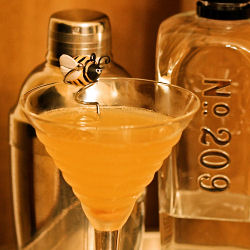 Last weekend, Cameron and I spent the better part of our monthly cocktail budget on a pair of tickets to the Independent Spirits Fest. Although my mom thought it sounded like the kind of groovy gig where you’d follow your bliss, it’s actually a trade show for distillers who aren’t aligned with any of the booze juggernauts.
Last weekend, Cameron and I spent the better part of our monthly cocktail budget on a pair of tickets to the Independent Spirits Fest. Although my mom thought it sounded like the kind of groovy gig where you’d follow your bliss, it’s actually a trade show for distillers who aren’t aligned with any of the booze juggernauts.
One of the best Fest perks was the opportunity to taste a number of liquors you can’t easily put your hands on, either because they’re too rare (often combined with “too pricey”), or too new to find in stores. With more than 30 exhibitors filling two small conference halls, we decided to focus on those near to our heart: Folks making booze in Northern California.
Between us, we tasted 20+ locally-produced items from a dozen different producers over the course of the evening. (Don’t worry: Most ended up in the spit bucket, and we took a cab home.) Some names you’d recognize from the shelf of your local bar, like Junipero gin and Hangar One vodka. But many new-to-us discoveries — like St. George’s lovely single malt, a bierschanaps made in Mountain View, and Charbay’s haunting pastis — were almost worth the cost of admission.
Best of all, it was a treat to find so many liquors produced within 100 miles of our home bar. Of the major booze families, I think we’re really only lacking a local American-style whiskey (one’s coming soon from Pioneer Spirits in Chico, with any luck) and a tequila equivalent, which can only be a matter of time given the mezcal explosion and the Bay Area’s love affair with agave.
But even after Wednesday’s Dark Days post, I can’t say that we’re going totally loca-boire. I think it’s safe to say, however, given the diversity of what we found — gin, whisky, rum, vodka, brandies, eaux de vie, liqueurs of all sorts — you’ll start seeing a lot more local products on our shelf, and on the blog.
—-
But on to this week’s drink: I’d been playing with honey drinks for a while, but it wasn’t until I sat down with my brand-new (to me) copy of David Embury’s classic The Fine Art of Mixing Drinks that I found one that really appealed to my tastes. Early in the book, Embury holds forth on the dark days of Prohibition and the birth of a number of “pernicious” cocktails, including a concoction christened the Bee’s Knees — equal parts honey, lemon, and gin. Thankfully, the days of bathtub gin are long behind us, and the modern version of the drink (which Embury endorses in later chapters) calls for saner proportions.
The glorious thing about the Bee’s Knees — which fully lives up to its name — is that it’s another one of those drinks you can easily make with ingredients you keep around the house. And, if you’re lucky like us, even with ingredients grown or distilled within a few miles of home. Careful observers will note it’s a close relative of the Whiskey Sour, and it shares that drink’s easygoing ways.
Although they weren’t exhibiting at the Fest, our favorite white liquor these days is sassy 209 Gin, distilled along the San Francisco waterfront at Pier 50 (a full 6 miles from our door, if you’re counting). It’s a lovely, mixable spirit, well-balanced but spunky.
The honey we get from Meeks’ in Soquel (72 miles) is fairly solid stuff. To bring it to a spreadable consistency, we usually warm the jar in a small saucepan of water. Alas, that’s not such a clever idea when mixing drinks: Hot honey isn’t exactly conducive to a crisp and cool cocktail, and it seizes back up as soon as it hits the ice. The problem’s easily remedied by using honey syrup: Heat equal parts honey and water in a pan, stir until dissolved, then pour into a bottle for storage (in the fridge, please).
Last but not least, there’s lemon juice. Although local honeybees are big fans of our backyard Meyer lemon tree, its current crop of fruit isn’t quite ripe. Luckily, a number of the farmers at the Ferry Building market keep us well supplied with Eureka lemons. In a few weeks, when our lemons turn yellow at last, this drink’ll get about as local as can bee.
Bee’s Knees
2 oz dry gin
1 oz lemon juice
1 oz honey syrup
Shake all ingredients with ice, and strain into a chilled cocktail glass.
———-
Drink of the Week, 1 Year Ago: Moscow Mule
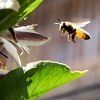

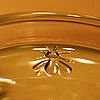
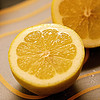
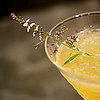




Comment by Dagny
Ahhh. Now I understand the Persephone’s Bees that they serve at Kitty’s in Emeryville. Instead of gin, they use Pearl pomegranate vodka. I’ll now have to try the original. Thanks.
Posted on 10.19.07 at 8:23AM
Comment by Ian
Interesting, I’d been making this as a 3/1/1. With the honey being only a fifth of the volume of the drink, I found that you can stir before you put the ice in, and the honey will dissolve. Then I shake. I’ll have to try it this way, it seems like less of a pain.
What were the flowers that the bees made the honey from? I first tried it with clover honey and was not impressed, but then I tried wildflower honey. It’s amazing how much better it was.
Posted on 10.19.07 at 8:45AM
Comment by Anita
Dagny: That’s a great cocktail name 🙂
Ian: The honey we used is a fairly spicy alfalfa honey; I think it’d be fine with clover, but not as interesting.
Regarding ratios… we tried it with less honey and didn’t like it as much, It didn’t occur to me to try it with a greater amount of gin, as it seemed plenty strong.
If you’re using honey syrup in another recipe, bear in mind that the diluted syrup is roughly half as sweet as honey.
Posted on 10.19.07 at 9:37AM
Comment by erik_flannestad
I recently tried the San Francisco Bay Area Beekeepers Blend from Marshall’s Honey. Wow, is it amazing and complex!
I usually buy honey from Jan C. Snyder at the Alemany Farmers’ Market. He’s from La Honda, which is only 44 miles away. Also really outstanding stuff, though the tarweed, eucalyptus, and milk thistle honies are a bit much for me.
Posted on 10.19.07 at 10:45AM
Comment by Jim
Honey in a cocktail? I’m fascinated…never tried it. Never been a gin guy, either, but this drink sounds promising…
Posted on 10.19.07 at 12:31PM
Comment by Ian
Just to be clear with the ratio thing, I’m talking 1.5 oz, .5 oz, and .5 oz respectively. I hadn’t intended to imply 3 oz of gin, which I think I did by not specifying parts instead of ounces.
It is fairly strong, but I didn’t use a very aggressive gin when I mixed it. It might have not cut through the honey as well.
Posted on 10.19.07 at 1:29PM
Comment by erik_flannestad
I have a love hate relationship with Meyer Lemons in cocktails.
Short answer, is, they are really only best in cocktails specifically designed for them. The difference in acidity of the juice and the thyme/pine flavor of the peel can make them inappropriate to use as a straight substitute for lemon juice or zest.
That said, their flavors work very well with Rye Whiskey, especially those from Buffalo Trace/Sazerac.
Oh, and if you leave them hang on the tree for an extra long time, they start to sweeten and the orange part of the hybrid really starts to come to prominence in the flavor. Yummy!
Posted on 10.19.07 at 2:14PM
Comment by Anita
Erik: I wish we went through honey faster. There are so many I want to try, but it takes us a year to get through a jar. Well, maybe not now that we know about this drink 😉
Jim: Let us know what you think if you try it. It’s hard for me to guess if you’ll like it, as I love gin!
Ian: Oh, I got that it. But thanks for clarifying for anyone who might’ve been confused. I probably should have said “It didn’t occur to me to try it with a greater proportion of gin relative to the other ingredients…”. The 209 isn’t super-hot, but it does have some personality; as always, we strongly encourage tinkering to adjust for fruit variety, liquor profiles, and the drinker’s personal palate.
I was surprised to find I liked the Bee’s Knees more when made to the ratios above than a variation I tried that was more like 4:2:1, as I tend to like my sours rather sour. But if you take too much of the honey away, you lose its character and end up with just sweetness, IMHO.
I noticed that CocktailDB also calls for a 3:1:1 ratio… I may give this a try over the weekend once I restock my citrus supplies. But I know for a fact that I really like it the way it’s written above — the only possible improvement would be for me to LOVE it. Which, you know, I can live with.
Erik again: I find the lemon difference less noticeable with our homegrown Meyers than with the usually very-ripe ones you tend to find in stores. Ours rarely stay on the tree long enough to bring out their extra sweetness; they’re less acidic than Eurekas, but they’re no less tart — if that makes any sense. Gotta love microclimates.
I hear you loud and clear about the rye affinity; am looking forward to my first Rye Sour of the year in a couple of weeks.
Posted on 10.19.07 at 2:27PM
Comment by erik_flannestad
Oh yeah, best meyer lemon use I’ve found so far:
Homemade pizza crust with Backyard Meyer Lemon slices, Farmers’ Market Asian Pears, and Bellwether Farms Fromage Blanc seasoned with lemon zest and fresh oregano.
Posted on 10.19.07 at 3:37PM
Comment by Cindy
I do have all these ingredients at home,
I’ll definitely give it a try!
Posted on 10.20.07 at 1:24PM
Comment by Nina
I just made this — delicious! Perfectly balanced, and a lovely flavor. I don’t know if I can have just one, though. 🙂
Posted on 10.20.07 at 8:54PM
Comment by Tea
Thanks for the Friday sample–I am in love! Perhaps I’m not a cocktailer because I had yet to meet one that made me melt…
Posted on 10.21.07 at 2:19PM
Comment by Dagny
I am used to getting Meyers from my aunt’s tree. Often the lemons have been sitting there for some time when I pick them, so I have come to think of Meyers as being sweeter and less acidic than Eureka. The things I learn through blogs.
And I’m partial to the Wildflower honey from Bee Kind. It has a kind of lemony flavor to it that I noticed the first time I used it in my tea.
Posted on 10.21.07 at 5:38PM
Comment by Ken
I agree that Meyer lemons are usually best in cocktails designed especially for them, but I’ve had pretty good luck with Meyer lemons in the Jack Rose.
Posted on 10.22.07 at 1:19PM
Comment by Kat
I absolutely hated honey as a child – and would quietly look with disgust at my sister who would gleefully eat peanut butter and honey sandwiches. As an adult, I can’t get enough! The drink looks and sounds so good…I’m definitely going to have to get the martini glasses out to try one.
Posted on 10.23.07 at 6:00PM
Comment by Dr. Judy
Where did you get the lovely glasses…with bees?
Posted on 10.31.07 at 11:43AM
Comment by Anita
Erik: The pizza sounds fabulous. We’ll be over around 8? 🙂
Cindy: I hope you do. Please let us know how it turns out.
Nina: That is the problem, isn’t it?
Tea: Tea and Honey, it’s a natural.
Dagny: We’re using an alfalfa honey, which has a fairly pronounced flavor. I bet wildflower or sage would be yummy, too.
Ken: That sounds delish, too. Our meyers are mutants, and we pick them when they’re pretty green. I’m guessing that’s why they work OK for us, but it seems you’re in the majority.
Kat: I don’t think we ever ate honey as kids, oddly enough. (Maybe my mom doesn’t like it?) But I’m definitely hooked now.
Judy: Oh, the hive-shaped glasses are from Crate and Barrel — they’re called “rhythm”. The bee swizzle is a custom creation: a wooden bee from a broken honey dripper, perched atop a spiral cocktail pick.
Posted on 10.31.07 at 12:07PM